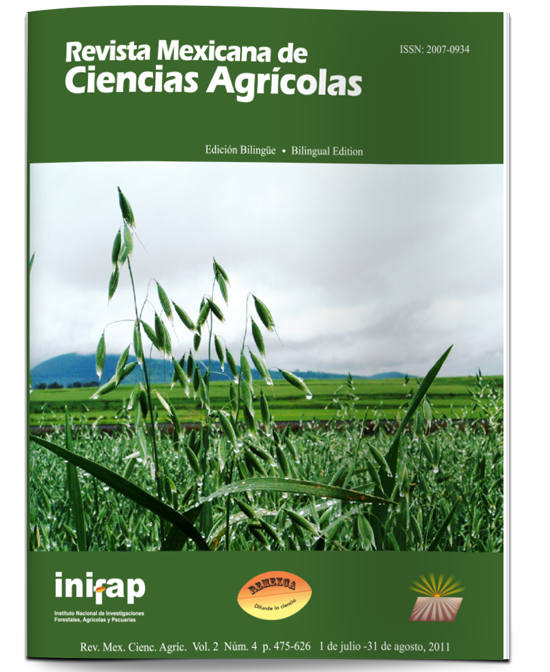IRRIGATION TECHNIQUE TO INCREASE THE EFICIENCY OF WATER USE IN TOMATO
DOI:
https://doi.org/10.29312/remexca.v2i4.1634Keywords:
Solanum lycopersicum L., chemical signals, root-shoot communicationAbstract
The aim of this research was to study in hydroponics and greenhouse conditions the effect of two levels of usable moisture from the substrate in tomato plants (Solanum lycopersicum L.), by the irrigation technique of partial root drying (PRD). For that, physiological variables were evaluated (dry matter of leaf, stem, root and fruit, water relations, gas exchange, yield), fruit quality (firmness, total soluble solids, pH and electrical conductivity) and the efficiency of water use. The experiment was done in Lomas de San Esteban, Texcoco, Mexico State in 2006. Plants grew in homogeneous volume containers with tezontle, the root was divided in two parts and two available moisture (AM) treatments were applied residual in substrate, control: 80%≤ AM≤ 100% and 80%≤ AM≤ 100% and PRD: 80%≤ AM≤ 100% and 30%≤ AM≤ 100%. The treatments started 28 days after transplantation and continued until the end of the experiment. Results indicated that PRD treatment, showed statistically significant differences (p≤ 0.05) than the control, in relation to CO2 fixation rate (PRD, 17.67 and control 9.23 μmol m-2 s-1) at 86 days of initiating the treatment (DAIT), evapotranspirated volume per plant throughout the experiment (PRD 186.7 L and control 229 L), fruit quality increased: firmness 25%, total soluble solids 13% and electrical conductivity 13%, compared with control; efficiency in water use (EWU) based on dry matter increased by 29% and instantly EWU was 57, 61 and almost 100% respect to the control at 65, 80 and 86 DAIT respectively, without affecting yield (PRD 363.2 g and control 345.8 g) and total water potential (PRD -0.54 and control -0.57; PRD -0.46 and control -0.55 MPa), at 79 and 118 DAIT respectively.
Downloads
Downloads
Published
How to Cite
Issue
Section
License
The authors who publish in Revista Mexicana de Ciencias Agrícolas accept the following conditions:
In accordance with copyright laws, Revista Mexicana de Ciencias Agrícolas recognizes and respects the authors’ moral right and ownership of property rights which will be transferred to the journal for dissemination in open access. Invariably, all the authors have to sign a letter of transfer of property rights and of originality of the article to Instituto Nacional de Investigaciones Forestales, Agrícolas y Pecuarias (INIFAP) [National Institute of Forestry, Agricultural and Livestock Research]. The author(s) must pay a fee for the reception of articles before proceeding to editorial review.
All the texts published by Revista Mexicana de Ciencias Agrícolas —with no exception— are distributed under a Creative Commons License Attribution-NonCommercial 4.0 International (CC BY-NC 4.0), which allows third parties to use the publication as long as the work’s authorship and its first publication in this journal are mentioned.
The author(s) can enter into independent and additional contractual agreements for the nonexclusive distribution of the version of the article published in Revista Mexicana de Ciencias Agrícolas (for example include it into an institutional repository or publish it in a book) as long as it is clearly and explicitly indicated that the work was published for the first time in Revista Mexicana de Ciencias Agrícolas.
For all the above, the authors shall send the Letter-transfer of Property Rights for the first publication duly filled in and signed by the author(s). This form must be sent as a PDF file to: revista_atm@yahoo.com.mx; cienciasagricola@inifap.gob.mx; remexca2017@gmail.
This work is licensed under a Creative Commons Attribution-Noncommercial 4.0 International license.



